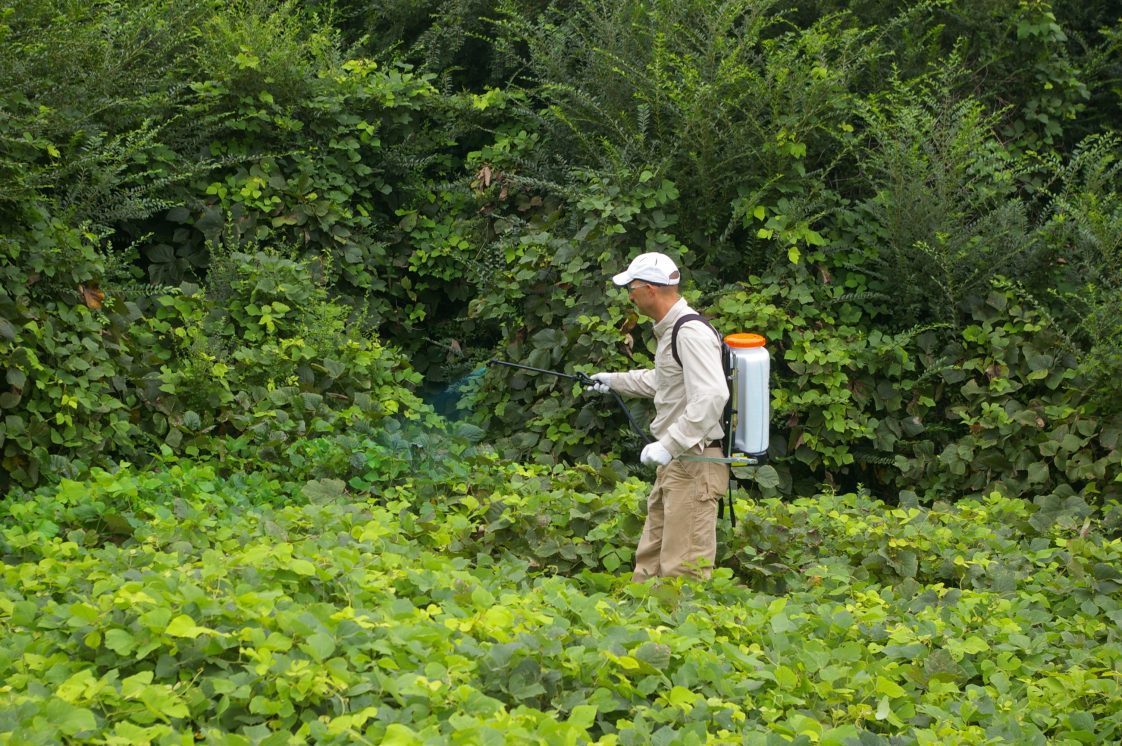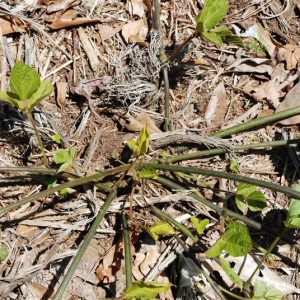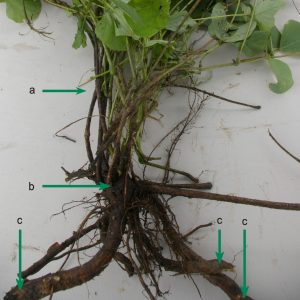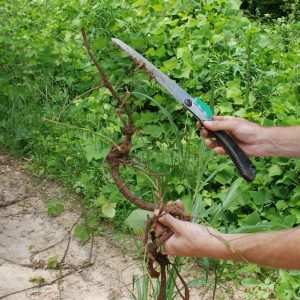Forestry & Wildlife

Kudzu is a frequent problem in residential areas. Learn various control methods and herbicide recommendations presented in an easy-to-read FAQ format.
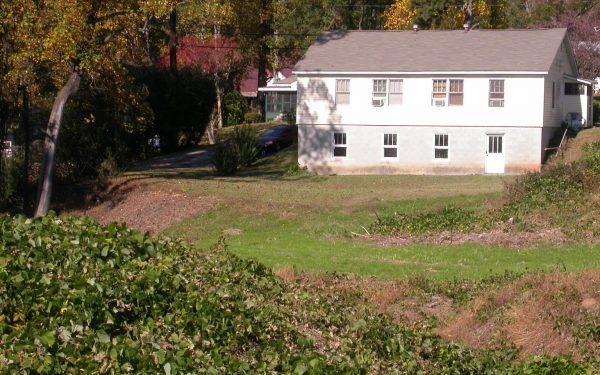
Figure 1. Kudzu infestation in residential area. (Photo credit: Daniel R. Suiter, University of Georgia. Bugwood.org)
Kudzu control can be a frustrating problem in residential settings. It frequently grows unchecked along woodland edges near homes, vacant lots, and property lines (figure 1). Its rapid growth and aggressive nature can make it seem uncontrollable in these situations. To make matters worse, kudzu is the primary host plant for the kudzu bug. This obnoxious insect pest has given many homeowners another reason to aggressively control kudzu on their properties. Here are some of the most frequently asked questions concerning kudzu control around homes and in urban settings and green spaces.
Will Repeated Mowing or Cutting Work to Control Kudzu?
To control kudzu by repeated mowing or cutting, you must do two things. First, cut every vine to the ground. This is difficult for rotary mowers as many vines lie flat on the ground. Simply cutting kudzu back (pruning or trimming) to keep it out of the lawn or at your property edge will not provide long-term control. Second, repeated cutting or mowing must continue until the kudzu no longer regrows. This technique may take many years of repeated mowing or cutting every week during the summer. Kudzu can tolerate occasional mowing or trimming, but it does not tolerate weekly defoliation to the ground. If you start a mowing or cutting regime but do not follow through for a few weeks, the kudzu will regrow.
I Have Tried to Dig Up Kudzu and Found a Large Woody Root. Do I Need to Remove the Whole Root to Stop New Growth?
No, you do not need to remove the whole root. The large root is a storage organ loaded with energy reserves, but it cannot sprout. Kudzu grows from seed and root crowns. You can see these root crowns if you follow a vine to where it roots in the soil (figure 2). Dig just a little around it, and you will see several buds, new sprouts, or mature vines emerging from just at, or slightly below, the soil surface. This is the root crown (figure 3).
To stop new kudzu vine growth, cut just below the root crown and remove it from the soil (figure 4). Kudzu cannot regrow from below the root crown and does not sprout from lateral roots. Sometimes, vines may be buried under a few inches of organic matter and leaf litter. This gives them the appearance of lateral roots, but they are not. Buried vines can root, making control more difficult because these hidden vines may produce many new shoots.
- Figure 2. Kudzu root crowns are easiest to spot in the early spring.
- Figure 3. Kudzu vines (a) originate from the root crown (b). The tubers (c) are storage organs found beneath the root crowns.
- Figure 4. Small kudzu root crown removed from the soil.
What Is the Best Tool to Remove the Root Crowns?
Use a shovel or pick axe to expose the base of the root crown. Then, use a sharp hatchet, axe, or small handsaw to cut the root below the root crown. A shovel or hoe may not be adequate for the job as the roots are fibrous or woody. Pruning shears may work for severing smaller root crowns but not for large ones.
What Herbicides Can I Use to Treat Kudzu?
While several products are labeled for kudzu control in forestry and rights-of-way, a limited number of herbicides can be used for kudzu control in residential settings (table 1). These include products with the herbicide active ingredients glyphosate and triclopyr. These must be carefully used for foliar or cut stump and stem treatments according to label directions to prevent potential damage to nearby desirable vegetation, including trees, shrubs, flowers, grasses, and vegetable gardens. Be careful when treating kudzu along property lines. Clearly communicate with neighbors in these situations and read and always follow label instructions.
Table 1. Common Glyphosate and Triclopyr Products Available at Local Retail Garden Supply Stores
2Foliar rate = ounces of herbicide per gallon of water per square foot area to be treated. For example, 4oz/gal/500ft2 means that a 1-gallon solution (4 oz of herbicide in 1 gallon of water) will treat a 500 square foot area of kudzu. For reference, a typical 2-car garage is about 400 square feet. Using a gallon of herbicide solution on a smaller area is going off label and should not be done.
Always read and follow all directions on the herbicide label.
| Product Name1 | Active Ingredients (%) | Foliar Treatment Rate2 | Cut Stump Rate |
|---|---|---|---|
| Bayer Advanced Brush Killer Plus Concentrate | triclopyr amine (8.8) | 4 oz/gal/500ft2 | 100% |
| Ortho Max Poison Ivy and Tough Brush Killer Concentrate | triclopyr amine (8.0) | 4 oz/gal/800 ft2 | 100% |
| Roundup Concentrate Poison Ivy Plus Tough Brush Killer | glyphosate (18.0) + triclopyr amine (2.0) | 6 oz/gal/300 ft2 | 100% |
| Roundup Pro | glyphosate (41) | 2.67 oz/gal/1000 ft2 | 50% |
| Roundup Pro Concentrate | glyphosate (50.2) | 2.4 oz/gal/1000 ft2 | 50% |
What Is the Optimal Timing for Herbicide Treatment?
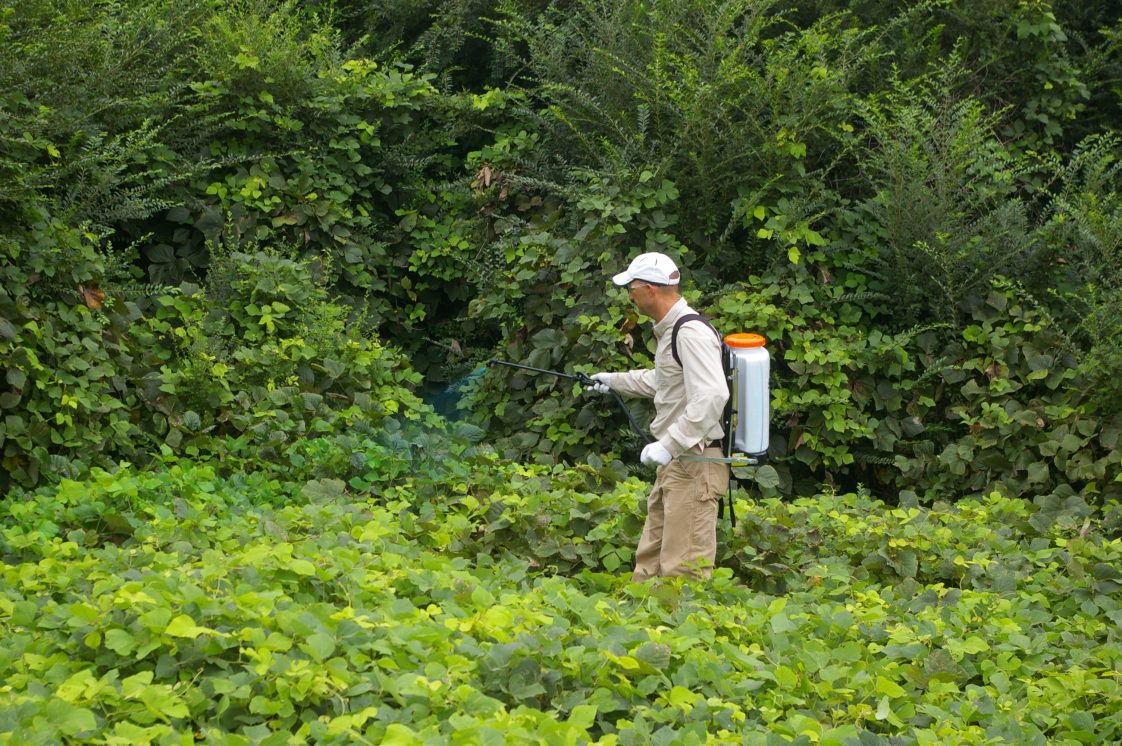
Figure 5. Spraying kudzu with a backpack sprayer is an effective application method for kudzu growing along the ground.
The optimal timing for foliar treatment (figure 5) is late summer or early fall. However, a single annual treatment is not sufficient. A better approach is to treat kudzu in the late spring or early summer after the leaves have fully expanded. Then, apply a second treatment in late summer or early fall to the new kudzu growth that emerged after the first treatment. This approach will be more effective than waiting until late summer to start a control program.
Late summer or fall is an effective time for cut stem treatments. However, cut stem treatments are often easiest to apply when the kudzu root crowns can be readily found. This is generally in the spring when new vine growth is initiated or after mowing or herbicide treatment when new sprouts begin growing. Root crowns are difficult to find after leaves have fully emerged. For more information on the cut stump treatment technique, please see “Cut Stump Herbicide Treatments for Woody Plant Control” (ANR-1465) on the Alabama Extension website at www.aces.edu.
What Should I Do if Kudzu Is Climbing Up into Large Trees?
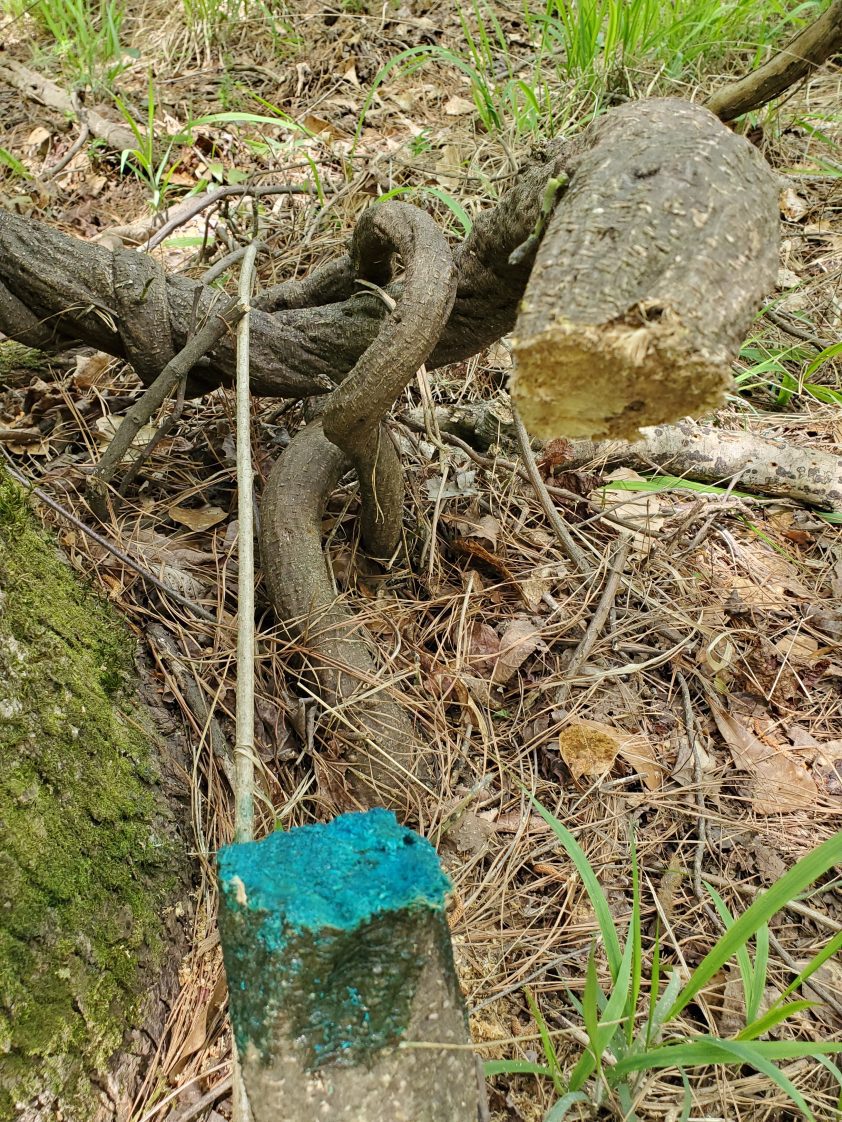
Figure 6. Kudzu vine treated with a cut stump application of glyphosate.
The safest approach is to cut any kudzu vines just above the ground and immediately treat the stem with one of the recommended glyphosate herbicides using the cut stump method (figure 6). It is not effective to spray only the lower leaves on a kudzu vine when it has grown up into a tree.
What Should I Do if Kudzu Is Smothering Small Tree Saplings I Want to Keep?
The recommended herbicides may injure or kill most tree saplings if sprayed on the leaves or green bark. The safest approach is to manually remove vines from saplings and then direct the herbicide spray away from the saplings and onto the kudzu. Be careful not to skin or break the bark of desired saplings to reduce the potential for herbicide uptake when treating kudzu.
How Many Treatments Will It Take to Completely Kill Kudzu?
None of these herbicides will completely kill all kudzu root crowns with one treatment. However, the younger, smaller root crowns can be killed with repeated treatment. Older root crowns may require many years of herbicide treatment to be killed. A quicker way to eliminate the older root crowns is to identify the location of larger ones following initial treatment as soon as they begin to sprout. These can then be physically removed or individually treated using the cut stump method.
Will Kudzu Bugs Control Kudzu without My Help?
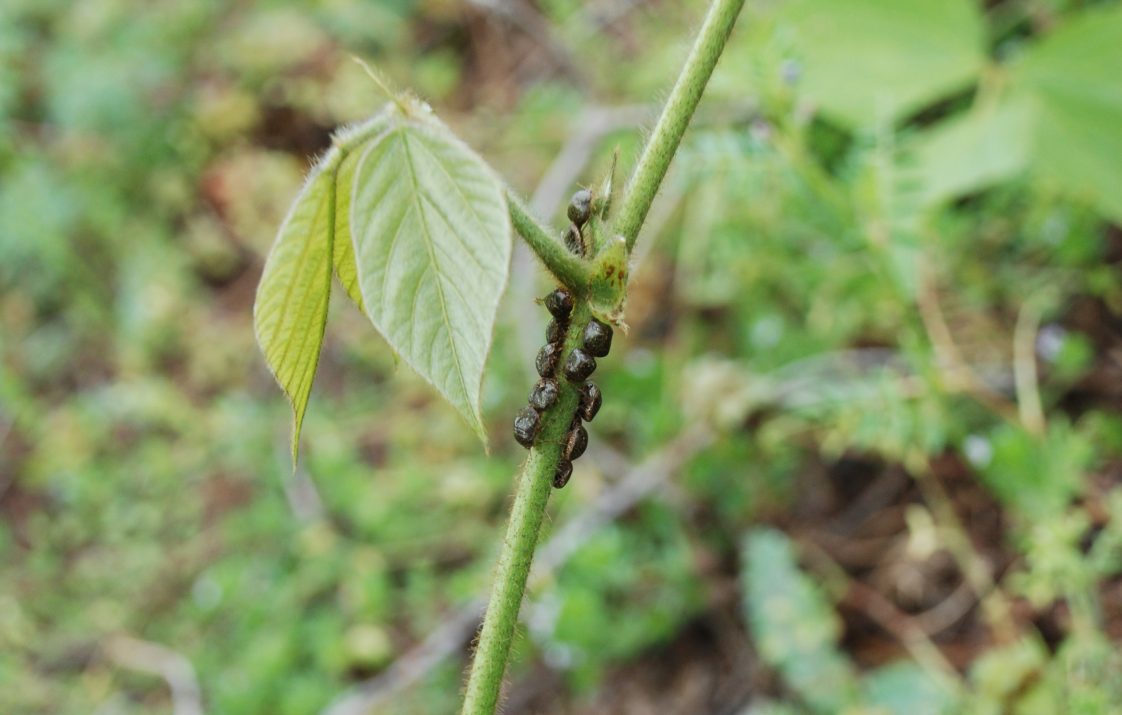
Figure 7. Kudzu bugs feeding on kudzu.
Kudzu bugs feed voraciously on new kudzu growth by sucking out the sap like aphids (figure 7). You will not see foliar damage as they do not chew holes in the leaves. Kudzu bugs may reduce kudzu growth, but they have not yet been shown to eliminate kudzu patches.
Will Killing the Kudzu Around My House Eliminate My Kudzu Bug Problem?
Controlling kudzu near your house may reduce the number of kudzu bugs and the foul chemical smell they emit when found in high numbers. However, kudzu bugs can fly for several miles, and some may still find your home. Kudzu bug populations continue to spread across the southeastern United States and are likely here to stay.
I Have an Undeveloped Lot Where I Plan to Build and that is Currently Infested with Kudzu. Should I Spray the Kudzu Before Initiating Construction?
Most construction projects that remove the topsoil will remove the kudzu root crowns. However, if the topsoil containing the root crowns is put back on the site, many will sprout and begin to reinfest the site. Aggressive kudzu treatment will be needed around the perimeter of the site where the soil is not disturbed. This can be initiated before or after construction.
 Revised by Nancy J. Loewenstein, Extension Specialist, Forestry, Wildlife, and Natural Resources, Auburn University. Originally written by Stephen F. Enloe, former Extension Weed Specialist, and Nancy J. Loewenstein, Extension Specialist, Forestry, Wildlife, and Natural Resources, Auburn University.
Revised by Nancy J. Loewenstein, Extension Specialist, Forestry, Wildlife, and Natural Resources, Auburn University. Originally written by Stephen F. Enloe, former Extension Weed Specialist, and Nancy J. Loewenstein, Extension Specialist, Forestry, Wildlife, and Natural Resources, Auburn University.
Revised April 2024, Kudzu Control in Residential Areas, ANR-2168

